Introduction
Are you tired of scrambling to figure out what to eat every day? Meal prepping is a game changing solution that helps you save time, stay organized, and eat healthier. With the right meal prep ideas, you can plan and prepare delicious meals in advance, ensuring you’re always ready for the week ahead.
Meal prep isn’t just about convenience; it’s about transforming your relationship with food. By dedicating just a little time each week, you can eliminate the stress of daily cooking, reduce food waste, and even save money. Furthermore, having ready-to-go meals makes it easier to stick to your dietary goals and enjoy homemade dishes without the hassle.
This guide offers 10 meal prep ideas that cater to a variety of tastes and lifestyles. Whether you’re a busy professional, a parent on the go, or someone looking to simplify their week, these ideas will inspire you to take control of your meals. Let’s dive into these practical and creative solutions that will change the way you plan your meals!
Table of contents
- Introduction
- 1. Start with Overnight Oats
- 2. Prepare Sheet Pan Meals
- 3. Cook Grains in Bulk
- 4. Portion Protein Ahead of Time
- 5. Use Mason Jar Salads
- 6. Freeze Smoothie Packs
- 7. Roast Vegetables for the Week
- 8. Invest in Versatile Sauces
- 9. Try One-Pot Recipes for Easy Meal Prep Ideas
- 10. Use Divided Containers for Balanced Meal Prep Ideas
- Conclusion: How to Make Meal Prep Ideas Work for You
- FAQs About Meal Prep Ideas
Why Meal Prep Ideas Are a Game-Changer for Busy Lives
Meal prep changes how you view food. Spending a bit of time to prepare your meals takes the stress out of cooking daily while keeping your meals healthy and delicious. Plus, meal prep helps you eat better without sacrificing flavor or variety. These easy tips can help you plan your week and build a routine, allowing you to focus on what really matters.
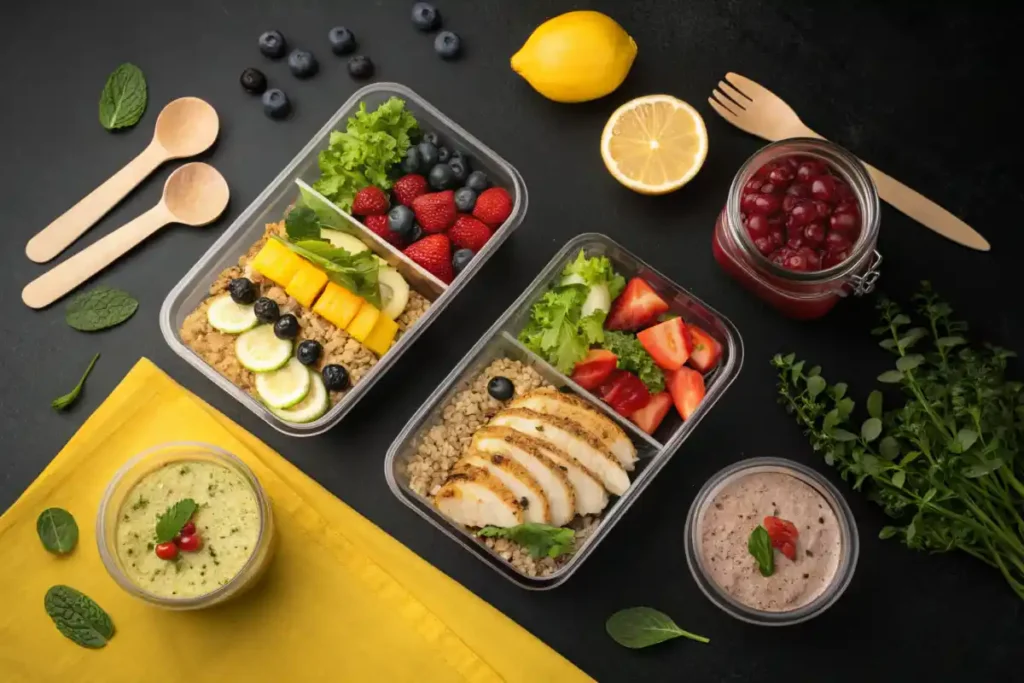
Simplify Your Week with These Creative Meal Prep Solutions
Is planning meals during a busy week tough for you? Meal prep is a helpful way to stay organized, save money, and enjoy homemade meals daily. These tips can help you save time and make meal prep more enjoyable by allowing you to personalize your dishes. Use these ideas to improve your meal prep skills and enjoy a week of easy and delicious meals!
1. Start with Overnight Oats
Overnight oats are a quick and healthy breakfast option for busy mornings. With just a few ingredients and little effort, you can make a tasty meal that’s ready to eat as soon as you wake up. Plus, overnight oats can be easily customized, so they can fit different tastes and diets.
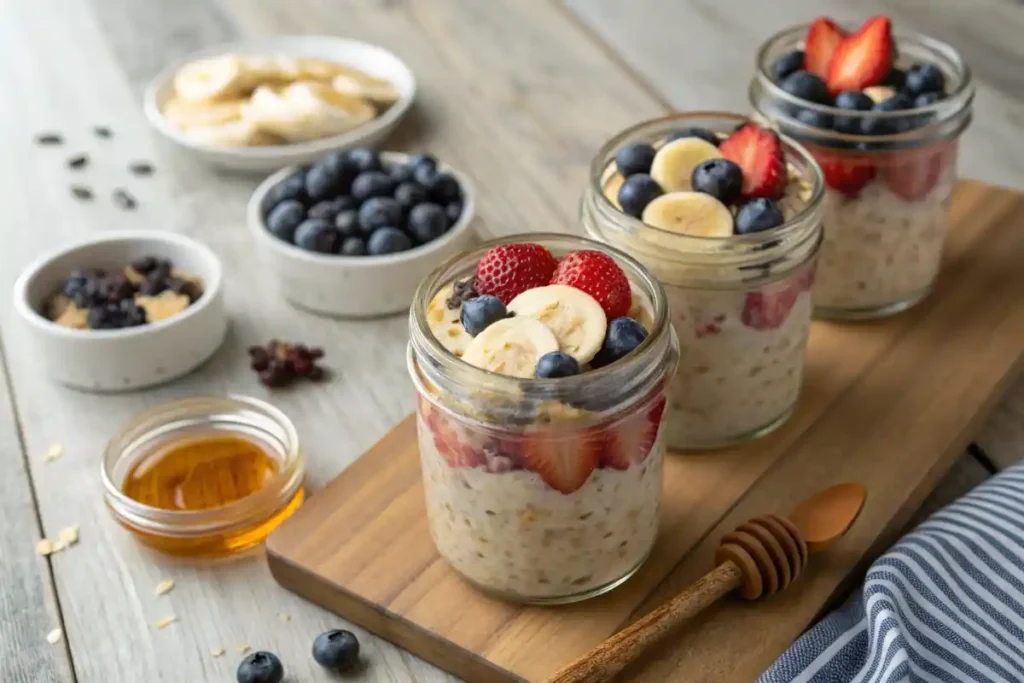
Ingredients for Basic Overnight Oats
- 1/2 cup rolled oats
- 1/2 cup milk (dairy or plant based)
- 1/4 cup Greek yogurt (optional, for creaminess)
- 1 teaspoon honey or maple syrup (optional, for sweetness)
- 1/4 teaspoon vanilla extract
- Toppings: Fresh fruits, nuts, seeds, or granola
Quick Recipe for Overnight Oats
- Combine the oats, milk, yogurt, sweetener, and vanilla extract in a jar or container. Stir until well mixed.
- Cover and refrigerate overnight, or for at least 4-6 hours, to allow the oats to absorb the liquid.
- Before serving, give the oats a good stir and add your favorite toppings, such as fresh berries, banana slices, or a sprinkle of granola.
Customization Tips
- For a Chocolate Version: Add 1 tablespoon of cocoa powder and a pinch of salt.
- For a Tropical Twist: Use coconut milk and top with mango and shredded coconut.
- For a Nut Butter Boost: Stir in 1 tablespoon of almond or peanut butter.
2. Prepare Sheet Pan Meals
Sheet pan meals are one of the easiest ways to prepare food. They take little effort and offer great convenience. You can cook a whole meal on one baking sheet, saving time and making cleanup easier. Plus, sheet pan meals are flexible; you can mix different proteins, vegetables, and seasonings for a variety of flavors.
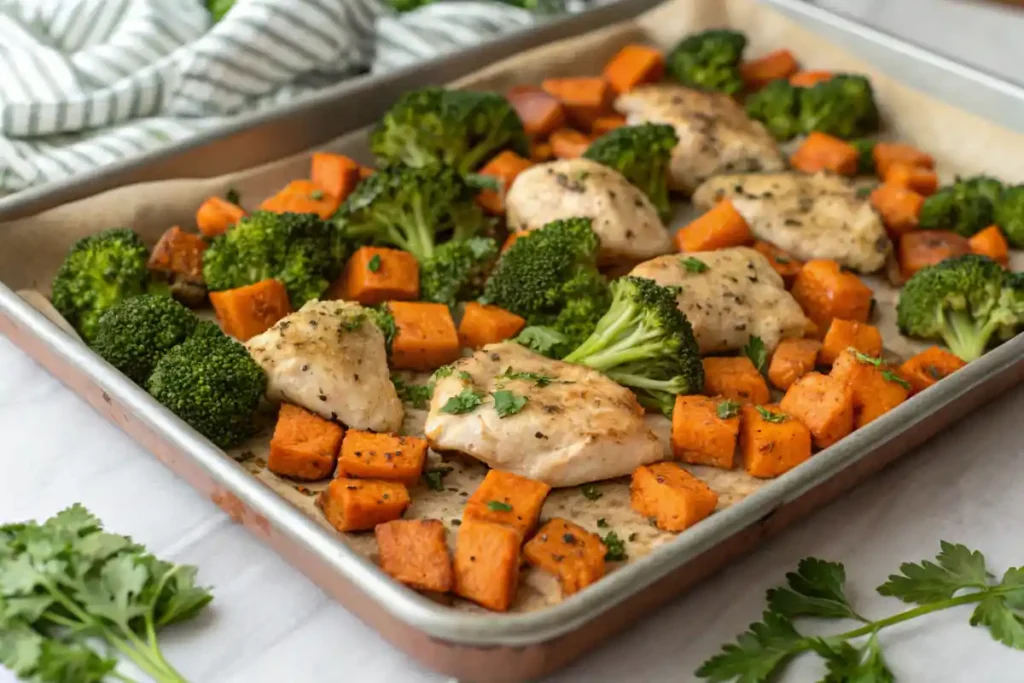
Ingredients for a Simple Sheet Pan Meal
- 2 chicken breasts or your preferred protein (tofu, fish, or shrimp).
- 2 cups mixed vegetables (e.g., broccoli, bell peppers, zucchini, or carrots), ensuring a balance of textures.
- 2 tablespoons olive oil, providing a light and even coating.
- 1 teaspoon garlic powder to enhance the flavor of your dish.
- 1 teaspoon paprika for a smoky and vibrant touch.
- Salt and pepper to taste, as they bring out the natural flavors of each ingredient.
Quick Recipe for a Sheet Pan Meal
- Preheat your oven to 400°F (200°C), ensuring even cooking throughout. Line a baking sheet with parchment paper to make cleanup faster.
- Arrange the chicken and vegetables evenly on the baking sheet. Furthermore, drizzle the olive oil over everything, making sure to coat all ingredients.
- Sprinkle the garlic powder, paprika, salt, and pepper evenly, and toss gently to ensure the seasonings are well distributed.
- Bake for 20-25 minutes, flipping the chicken halfway through to guarantee even browning. Simultaneously, monitor the vegetables for tenderness.
- Once done, divide the contents into meal prep containers, creating balanced meals that are ready for the week ahead.
Customization Tips
- For a Mediterranean Flavor: Add oregano, lemon juice, and olives to create a bright, herbaceous profile.
- For an Asian Twist: Incorporate soy sauce, sesame oil, and freshly grated ginger for bold, aromatic flavors.
- For a Spicy Kick: Sprinkle chili flakes or cayenne pepper to add heat and depth.
3. Cook Grains in Bulk
Cooking grains in bulk is a smart meal prep choice that gives you a flexible base for your dishes. Grains like rice, quinoa, or farro are nutritious and easy to cook in large amounts. Plus, having pre cooked grains saves time and makes it easy to put together healthy meals during the week.
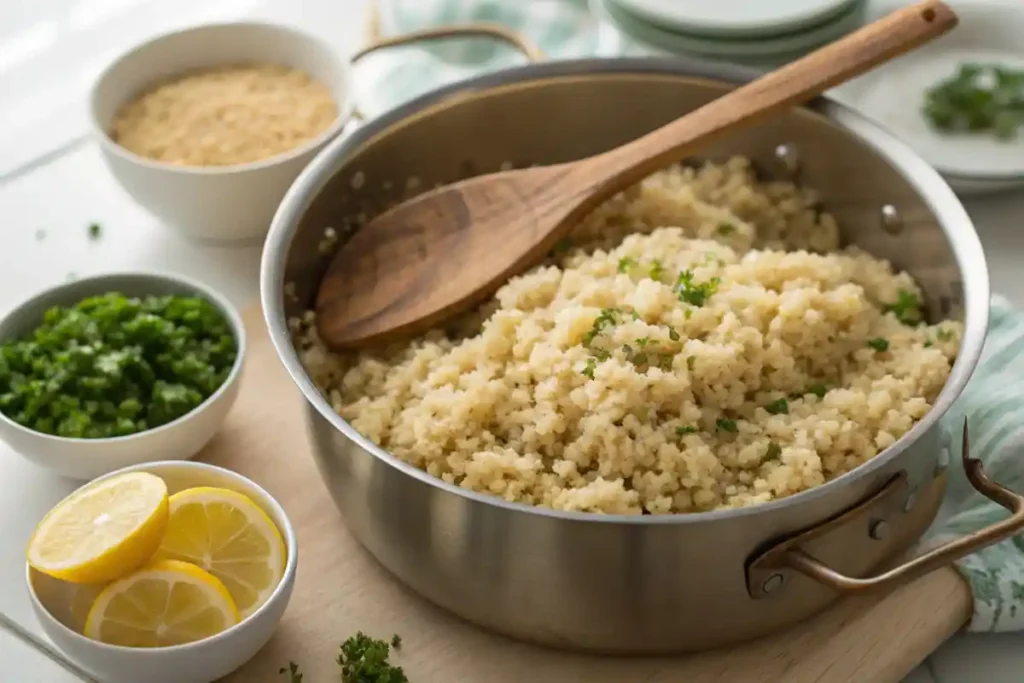
Ingredients for Bulk-Cooked Grains
- 2 cups uncooked grains (e.g., rice, quinoa, or farro).
- 4 cups water or broth for added flavor and richness.
- 1 teaspoon salt to enhance the natural flavors of the grains.
Quick Recipe for Cooking Grains in Bulk
- Rinse the grains thoroughly under cold water to remove excess starch and improve texture. Furthermore, this step prevents the grains from becoming sticky during cooking.
- In a large pot, bring the water or broth to a boil. Additionally, adding broth instead of water boosts flavor without extra effort.
- Stir in the grains and salt, then reduce the heat to low. Cover the pot with a tight-fitting lid to ensure even cooking.
- Cook according to the package instructions, typically 15-20 minutes for rice or quinoa and 25-30 minutes for farro. Stir occasionally to prevent sticking.
- Once the grains are tender, remove the pot from heat and let it sit, covered, for 5 minutes. This step allows the grains to absorb any remaining liquid, making them fluffier.
Creative Ways to Use Bulk-Cooked Grains
- Add to Salads: Toss cooked quinoa into a Greek salad with cucumbers, tomatoes, and feta for a refreshing lunch.
- Use in Stir-Fries: Pair brown rice with stir fried vegetables and teriyaki chicken for a quick and flavorful dinner.
- Make Grain Bowls: Combine farro with roasted sweet potatoes, kale, and tahini dressing for a hearty, plant based option.
Storage Tips for Cooked Grains
Allow the grains to cool completely before transferring them to airtight containers. Furthermore, dividing them into single-serving portions ensures convenience when assembling meals. Adding a splash of water when reheating keeps the grains moist and fresh-tasting.
By cooking grains in bulk, you’ll have a ready to use component that simplifies meal prep while adding variety and nutrition to your weekly menu.
4. Portion Protein Ahead of Time
Prepping protein in advance is a smart meal prep idea that helps you create balanced and satisfying meals effortlessly. Additionally, by cooking proteins like chicken, fish, tofu, or plant based alternatives in batches, you can save significant time during the week. Moreover, having pre-cooked protein on hand makes assembling meals quick and convenient.
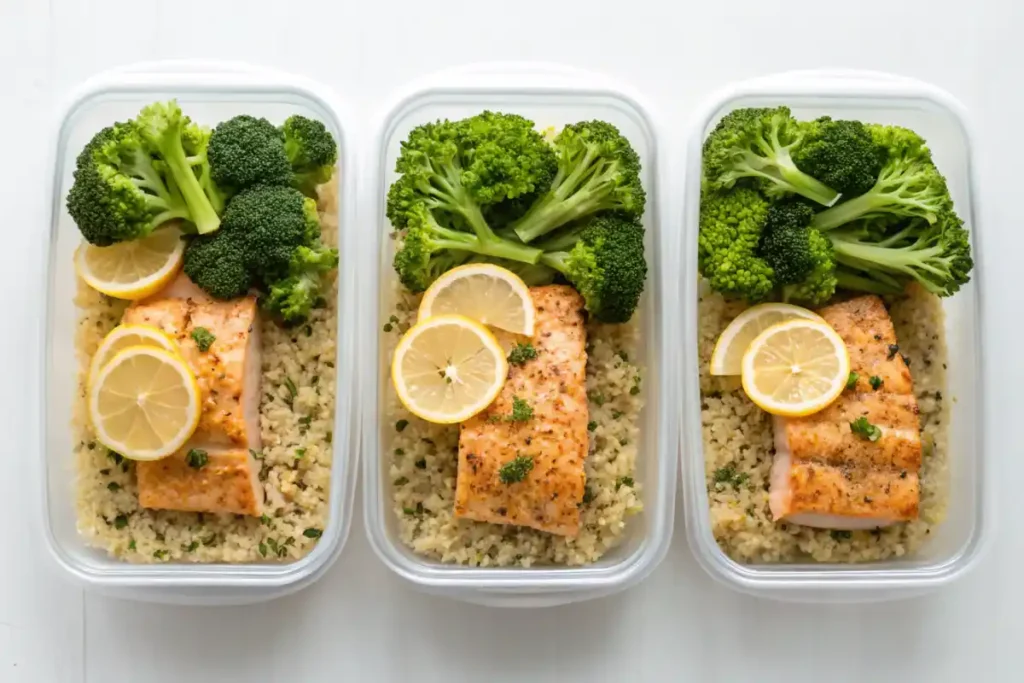
Ingredients for Prepped Protein
- 2 pounds chicken breast, tofu, or salmon (or your preferred protein).
- 2 tablespoons olive oil to prevent drying during cooking.
- 1 teaspoon garlic powder for a savory base flavor.
- 1 teaspoon paprika or any preferred seasoning blend.
- Salt and pepper to enhance taste.
Quick Recipe for Prepping Protein
- Preheat your oven to 375°F (190°C) or heat a grill for a smokier flavor. Furthermore, preparing the cooking area ensures even and consistent results.
- Place the protein on a baking sheet or grill pan. Additionally, brush each piece lightly with olive oil to retain moisture during cooking.
- Sprinkle the garlic powder, paprika, salt, and pepper evenly across all sides. Moreover, use your favorite seasoning blend to add variety and flavor.
- Bake for 20-25 minutes, or until the internal temperature reaches 165°F (74°C) for chicken and fish. For tofu, cook until golden and slightly crisp.
- Let the protein cool slightly before slicing or portioning into containers. This step prevents the juices from escaping and keeps the protein tender.
Creative Ways to Use Prepped Protein
- Add to Salads: Toss grilled chicken into a Caesar salad or tofu into an Asian slaw for a quick, flavorful lunch.
- Use in Wraps: Combine sliced protein with fresh veggies and hummus for an easy wrap.
- Pair with Grains: Add prepped salmon to quinoa or brown rice bowls for a nutritious dinner.
Storage Tips for Prepped Protein
Store cooked protein in airtight containers in the refrigerator for up to five days. Furthermore, freezing portions in resealable bags extends their shelf life, ensuring you always have a protein source on hand. Label containers with cooking dates to stay organized and reduce waste.
By prepping protein ahead of time, you’ll not only simplify your week but also ensure your meals remain flavorful and balanced.
5. Use Mason Jar Salads
Mason jar salads are an incredibly practical and visually appealing meal prep idea that simplifies lunch planning. Furthermore, their compact design allows for easy storage while keeping ingredients fresh and crisp. Additionally, by layering the ingredients strategically, you can ensure your salads stay flavorful and satisfying all week long.
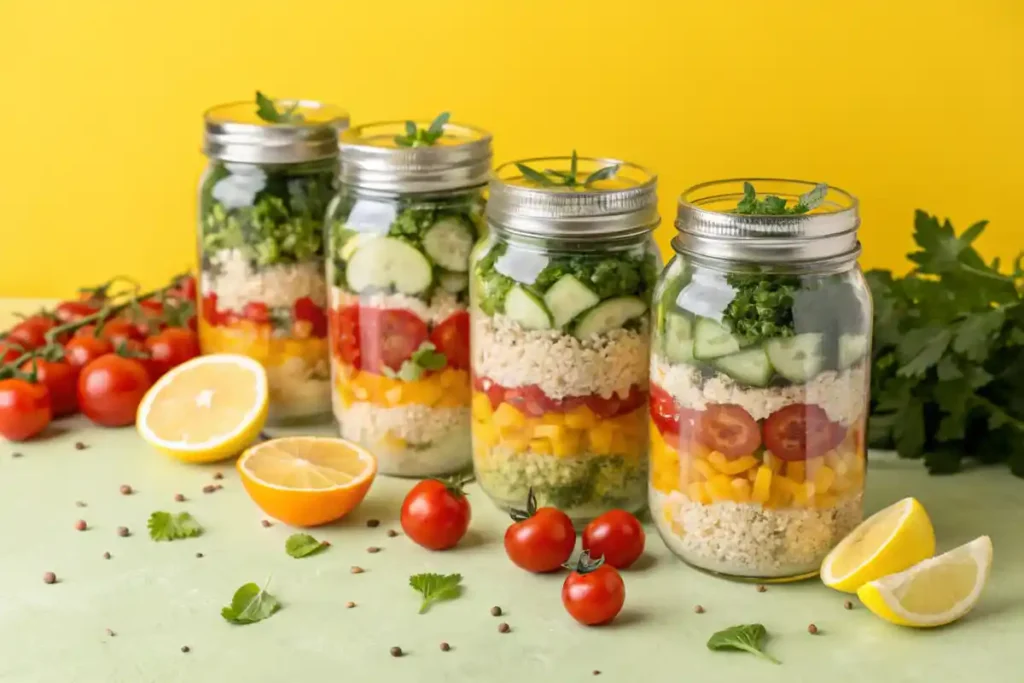
Ingredients for a Basic Mason Jar Salad
- 3 tablespoons dressing (e.g., vinaigrette, ranch, or tahini).
- 1/2 cup hearty ingredients (e.g., beans, quinoa, or chopped chicken).
- 1/2 cup chopped vegetables (e.g., cucumbers, bell peppers, or cherry tomatoes).
- 1/4 cup toppings (e.g., shredded cheese, nuts, or seeds).
- 2 cups leafy greens (e.g., spinach, kale, or romaine).
Quick Recipe for Mason Jar Salads
- Begin by pouring the dressing into the bottom of a mason jar. This placement ensures the greens and other delicate ingredients remain crisp.
- Add hearty ingredients like beans or cooked grains next, creating a sturdy base to prevent sogginess. Moreover, this layer protects the vegetables and toppings from absorbing the dressing prematurely.
- Layer chopped vegetables like cucumbers, carrots, or peppers over the base for added crunch. Additionally, this step adds vibrant colors to your salad.
- Sprinkle your preferred toppings, such as cheese, seeds, or nuts, for texture and flavor. Furthermore, these small additions elevate the salad’s taste.
- Finally, add the leafy greens on top to keep them fresh and crisp. When ready to eat, shake the jar to mix the dressing and enjoy directly or pour the salad into a bowl for serving.
Creative Flavor Combinations to Try
- Mediterranean Delight: Chickpeas, cherry tomatoes, cucumbers, feta cheese, and a lemon-oregano vinaigrette.
- Southwest Bowl: Black beans, corn, bell peppers, shredded cheese, and a creamy chipotle dressing.
- Asian-Inspired Salad: Edamame, shredded carrots, grilled chicken, sesame seeds, and a sesame ginger dressing.
Additionally, these combinations are endlessly customizable, making mason jar salads a versatile option for meal prep.
Storage Tips for Mason Jar Salads
Store the jars upright in the refrigerator for up to 4-5 days. Furthermore, using wide-mouth jars makes assembling and serving the salads much easier. Moreover, adding toppings like nuts or seeds just before eating keeps them crunchy and fresh.
By incorporating mason jar salads into your meal prep routine, you’ll not only save time but also enjoy flavorful, nutrient-packed meals throughout the week.
6. Freeze Smoothie Packs
Freezing smoothie packs is one of the most efficient meal prep ideas for quick and nutritious breakfasts or snacks. Moreover, this method allows you to pre-portion all the ingredients, so you only need to blend and enjoy when you’re ready. Additionally, smoothie packs help reduce food waste by keeping your ingredients fresh and ready to use.
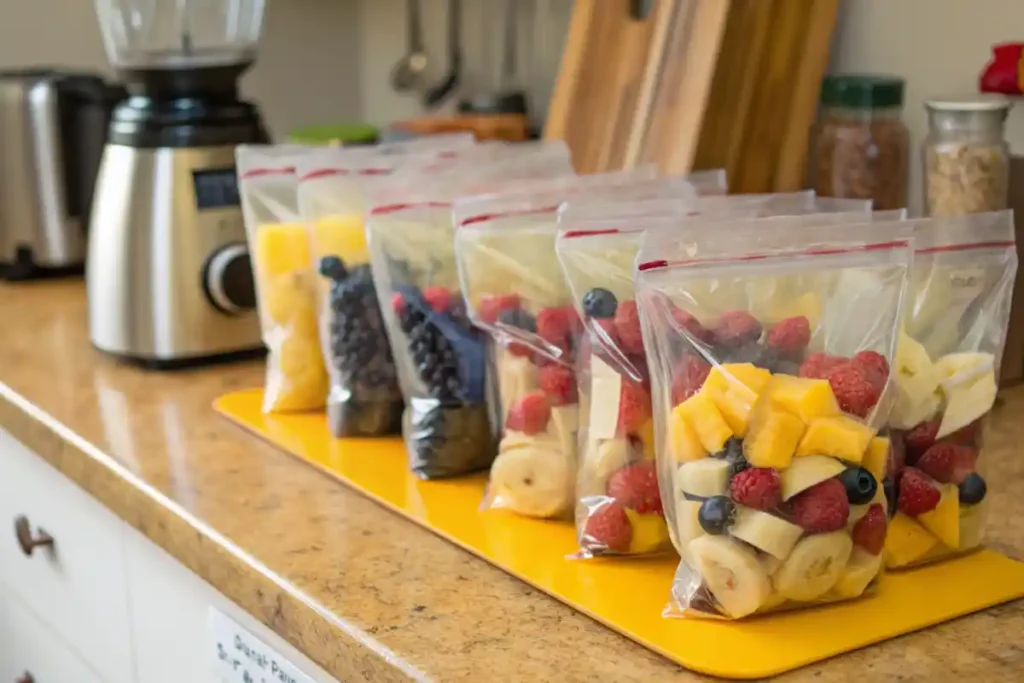
Ingredients for a Basic Smoothie Pack
- 1 cup frozen fruit (e.g., bananas, berries, mango, or pineapple).
- 1/2 cup greens (e.g., spinach or kale).
- 1 tablespoon seeds (e.g., chia seeds or flaxseeds).
- 1/4 cup yogurt (optional for creaminess).
- Liquid for blending (e.g., almond milk, coconut water, or regular milk, added when blending).
Quick Recipe for Freezing Smoothie Packs
- Start by portioning your frozen fruit into resealable freezer bags or airtight containers. Additionally, label each bag with the flavor combination for easier selection.
- Add your greens and seeds to the bags, ensuring the ingredients are layered for easy blending later. Furthermore, keeping the portions consistent ensures your smoothies will have the perfect texture every time.
- If using yogurt, freeze it in small dollops on a baking sheet before adding to the packs. This technique prevents the yogurt from sticking together.
- Seal the bags tightly, removing as much air as possible to prevent freezer burn. Store the smoothie packs in the freezer for up to 3 months.
Flavorful Smoothie Pack Combinations
- Berry Blast: Strawberries, blueberries, spinach, chia seeds, and almond milk.
- Tropical Paradise: Pineapple, mango, kale, coconut water, and flaxseeds.
- Green Energy Boost: Bananas, avocado, spinach, almond butter, and almond milk.
Moreover, you can easily customize these packs by adding protein powder, nut butter, or spices like cinnamon for added flavor and nutrition.
Tips for Using Smoothie Packs
When ready to blend, simply empty the contents of a pack into your blender, add your liquid of choice, and blend until smooth. Additionally, adjusting the liquid amount allows you to create your desired consistency, whether thick for a smoothie bowl or thinner for a drinkable texture.
By incorporating frozen smoothie packs into your meal prep routine, you’ll always have a healthy and refreshing option at your fingertips.
7. Roast Vegetables for the Week
Roasting vegetables in bulk is a versatile and time saving meal prep idea that adds flavor, nutrition, and variety to your meals. Furthermore, roasted vegetables can serve as a side dish, an addition to salads, or even the base for grain bowls. Additionally, this method brings out the natural sweetness of vegetables while creating a delicious caramelized texture.
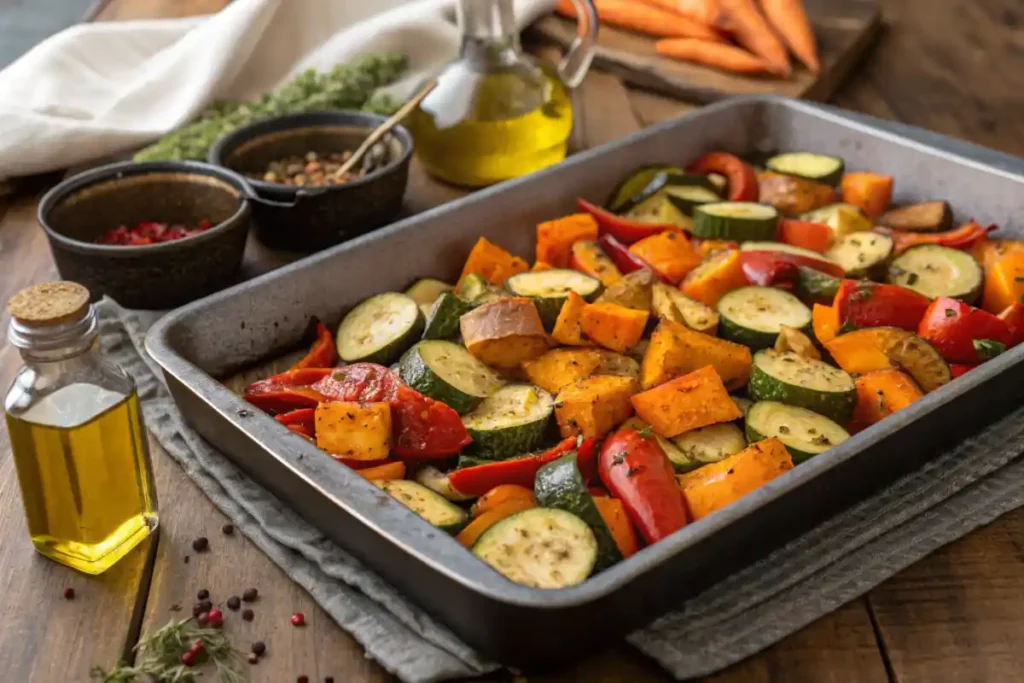
Ingredients for Roasted Vegetables
- 4 cups mixed vegetables (e.g., sweet potatoes, broccoli, carrots, zucchini, or bell peppers).
- 2 tablespoons olive oil for a light and even coating.
- 1 teaspoon garlic powder to enhance flavor.
- 1 teaspoon paprika or Italian seasoning for added depth.
- Salt and pepper to taste.
Quick Recipe for Roasting Vegetables
- Preheat your oven to 425°F (220°C). Line a baking sheet with parchment paper to prevent sticking and make cleanup easier.
- Chop the vegetables into evenly sized pieces to ensure uniform cooking. Additionally, this step helps prevent some pieces from overcooking while others remain underdone.
- Toss the vegetables with olive oil, garlic powder, paprika, salt, and pepper in a large bowl. Moreover, using your hands to mix ensures every piece is coated thoroughly.
- Spread the vegetables in a single layer on the baking sheet. Avoid overcrowding, as this helps achieve the best caramelization.
- Roast for 20-30 minutes, flipping halfway through for even browning. Remove from the oven once the vegetables are tender and slightly crispy at the edges.
Creative Ways to Use Roasted Vegetables
- Add to Salads: Toss roasted vegetables into a spinach or arugula salad with a tangy vinaigrette.
- Pair with Grains: Combine roasted veggies with quinoa, rice, or couscous for a hearty grain bowl.
- Use in Wraps: Add roasted vegetables to a tortilla with hummus or feta cheese for a quick and tasty wrap.
Storage Tips for Roasted Vegetables
Let the vegetables cool completely before putting them in airtight containers. Also, separating them into smaller containers makes it easier to grab and go. Reheat in the oven or microwave with a bit of olive oil to keep their texture and flavor.
By roasting vegetables ahead of time, you’ll always have a healthy and flavorful ingredient ready to elevate any meal.
8. Invest in Versatile Sauces
Incorporating versatile sauces into your meal prep is one of the easiest ways to enhance flavor while keeping your meals exciting. Furthermore, sauces act as the perfect complement to proteins, grains, and vegetables, ensuring that even the simplest dishes taste delicious. Additionally, preparing sauces ahead of time saves you from last-minute cooking stress and allows you to customize your meals effortlessly.
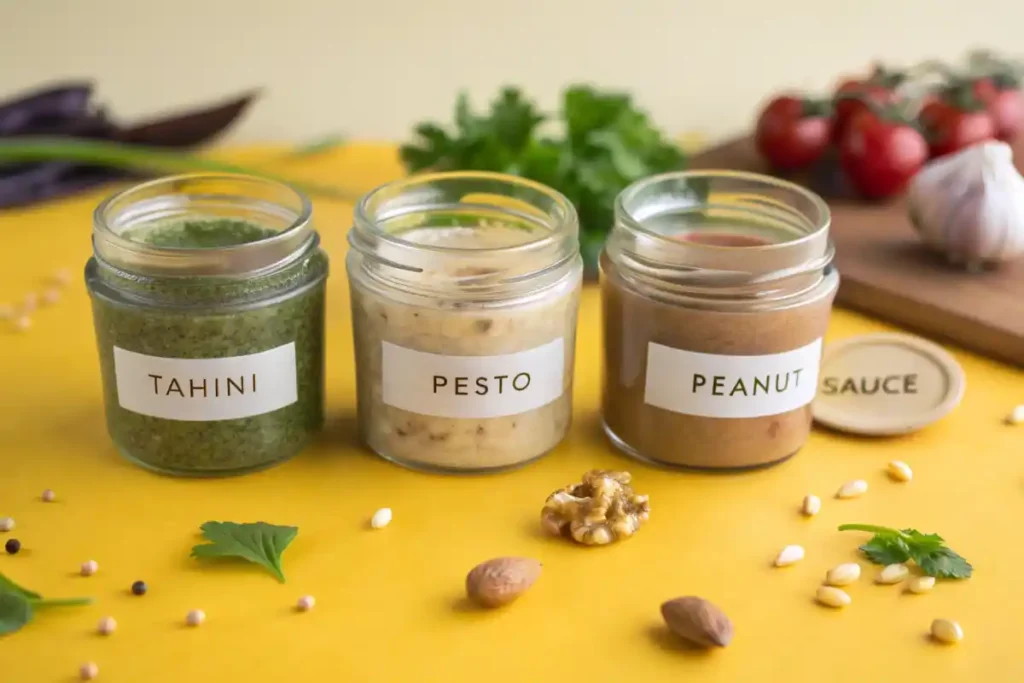
Ingredients for a Basic Tahini Sauce
- 1/4 cup tahini
- 2 tablespoons lemon juice
- 2 tablespoons water (adjust for desired consistency)
- 1 clove garlic, minced
- 1/2 teaspoon salt
- Optional: A pinch of cumin or smoked paprika for added depth.
Quick Recipe for Versatile Tahini Sauce
- In a small bowl, whisk together the tahini, lemon juice, and water until smooth. Moreover, adjust the water gradually to achieve your preferred consistency.
- Stir in the minced garlic and salt, mixing until well combined. Additionally, tasting and adjusting the seasoning ensures the sauce suits your palate.
- Transfer the sauce to an airtight container or jar and store it in the refrigerator for up to one week.
Creative Uses for Versatile Sauces
- Drizzle over Bowls: Add tahini sauce to grain bowls with quinoa, roasted vegetables, and chickpeas for a creamy finish.
- Spread on Wraps: Use it as a flavorful spread for wraps or sandwiches, elevating even the simplest meals.
- Dip for Snacks: Pair the sauce with fresh vegetables or baked pita chips for a quick, healthy snack.
Moreover, sauces like pesto, peanut sauce, or vinaigrettes offer even more ways to enhance your meal prep. By preparing a variety of sauces, you can create meals with different flavor profiles every day.
Storage Tips for Prepped Sauces
Store sauces in mason jars or airtight containers to preserve freshness. Furthermore, labeling them with preparation dates helps you keep track of their shelf life. Freezing sauces in small portions, such as ice cube trays, ensures they remain fresh and are easy to thaw when needed.
By investing in versatile sauces, you not only add flavor to your dishes but also simplify your meal prep routine, making it easier to enjoy delicious and varied meals throughout the week.
9. Try One-Pot Recipes for Easy Meal Prep Ideas
One-pot recipes are a meal prep idea that can completely transform the way you cook for the week. Furthermore, they save time, reduce cleanup, and deliver flavorful meals that are both satisfying and versatile. Additionally, cooking everything in a single pot allows the flavors to blend seamlessly, making these dishes a favorite among those who meal prep regularly.
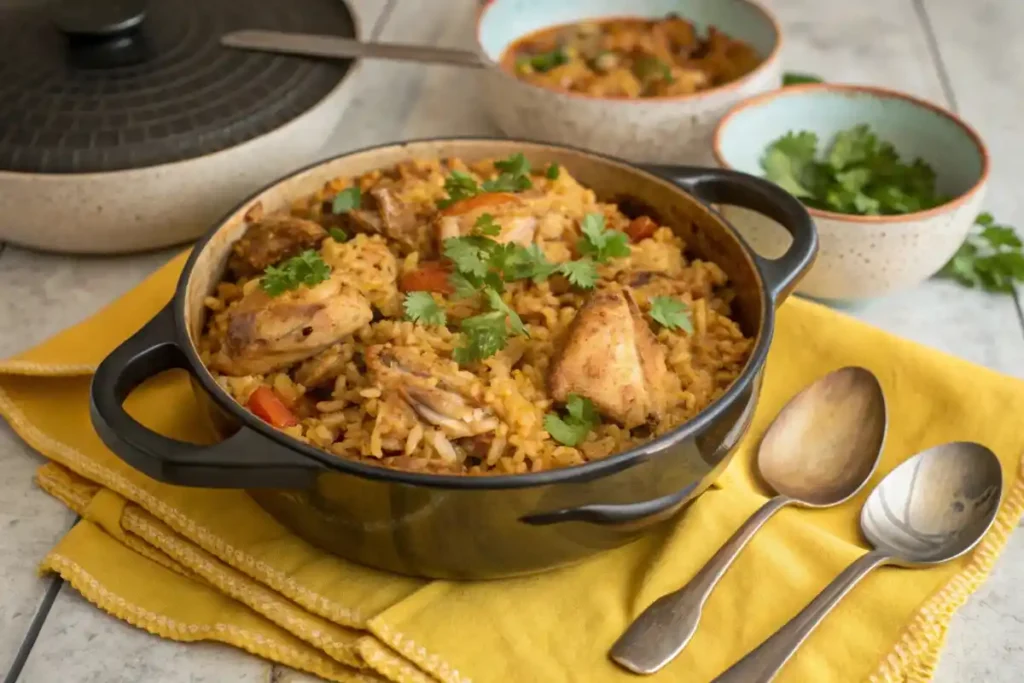
Ingredients for a One-Pot Meal Prep Idea: Chicken and Rice
- 2 chicken breasts, diced
- 1 cup rice
- 2 cups chicken broth
- 1 cup mixed vegetables (e.g., peas, carrots, or bell peppers)
- 1 tablespoon olive oil
- 1 teaspoon garlic powder
- 1 teaspoon paprika
- Salt and pepper to taste
Quick Recipe for a One-Pot Meal Prep Dish
- Heat olive oil in a large pot over medium heat and sauté the diced chicken until lightly browned. Furthermore, seasoning the chicken during cooking enhances its flavor and tenderness.
- Add garlic powder, paprika, salt, and pepper, ensuring every piece of chicken is evenly coated. Additionally, this step builds the dish’s flavor from the start.
- Stir in rice and mixed vegetables, combining the ingredients thoroughly for even cooking. Moreover, this step ensures the grains and vegetables absorb the savory flavors of the seasonings.
- Pour in chicken broth, bring the mixture to a boil, and reduce the heat to low. Cover the pot and let it simmer for 20-25 minutes until the rice is tender and the liquid is absorbed.
- Once done, fluff the rice with a fork and divide the dish into meal prep containers, making it easy to enjoy throughout the week.
Why One-Pot Recipes Are Perfect for Meal Prep Ideas
One-pot recipes stand out among meal prep ideas because they simplify the cooking process without compromising on taste. Furthermore, these meals provide flexibility, allowing you to experiment with different proteins, grains, and vegetables. Additionally, their ability to yield multiple servings makes them ideal for busy weeks.
Creative One-Pot Meal Prep Ideas
- Vegetarian Chili: A plant based one-pot recipe featuring beans, tomatoes, and warming spices for a hearty and filling option.
- Pasta Primavera: A creamy yet light dish that combines pasta with seasonal vegetables, garlic, and Parmesan.
- Spiced Lentil Stew: A high protein, one-pot recipe made with lentils, carrots, and aromatic spices like cumin and turmeric.
Storage Tips for One-Pot Meal Prep Recipes
Allow your one-pot meals to cool completely before transferring them into airtight containers. Furthermore, dividing them into single serving portions helps maintain freshness and makes reheating more convenient. Adding a splash of broth or water during reheating ensures the dish retains its original moisture and flavor.
By incorporating one-pot recipes into your meal prep ideas, you can streamline your week and enjoy flavorful, homemade meals with minimal effort.
10. Use Divided Containers for Balanced Meal Prep Ideas
Divided containers are an essential tool for anyone serious about meal prep ideas. These containers make it easy to portion your meals into balanced servings, ensuring that proteins, grains, and vegetables stay fresh and separate. Furthermore, they help you maintain variety and prevent the flavors from mixing, making each meal more enjoyable.
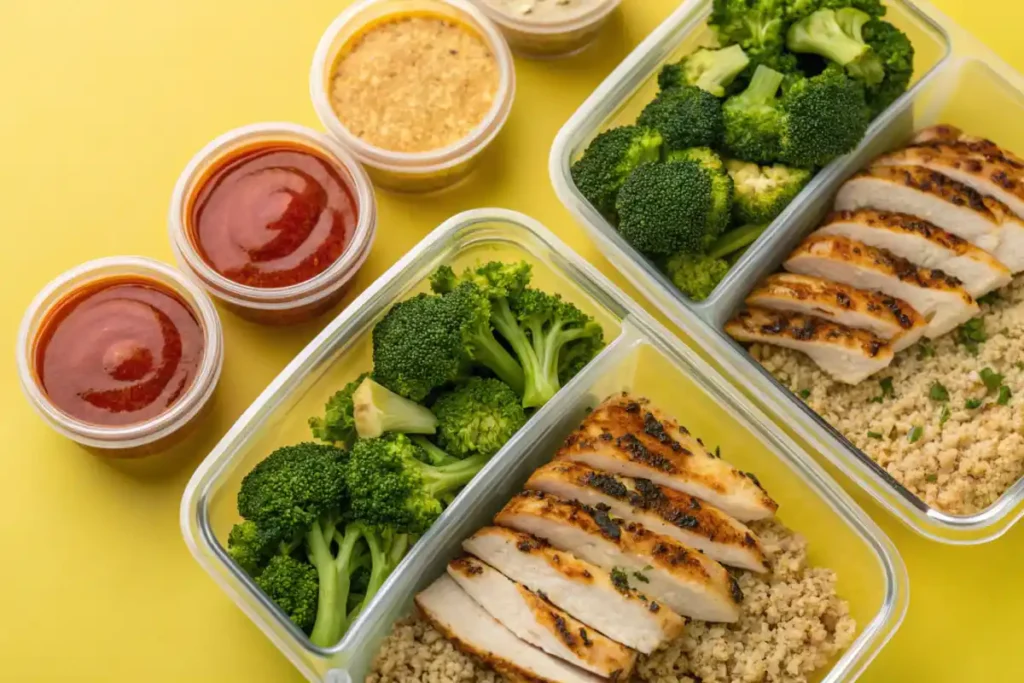
Why Divided Containers Simplify Meal Prep Ideas
Using divided containers takes the guesswork out of portioning your meals. Moreover, they allow you to balance your macros by keeping proteins, carbs, and vegetables perfectly proportioned. Additionally, they are reusable and stackable, saving both space in your fridge and time during your prep.
How to Use Divided Containers for Meal Prep
- Fill one section with a protein like grilled chicken, tofu, or salmon to keep meals satisfying.
- Use another section for grains such as rice, quinoa, or couscous to provide a hearty base.
- Add colorful vegetables like steamed broccoli, roasted carrots, or mixed greens in the final section for a boost of nutrients.
- If your container has a small section, use it for sauces or dips to enhance flavor without sogginess.
Creative Meal Prep Ideas with Divided Containers
- Mediterranean Bowl: Grilled chicken, couscous, and a side of roasted zucchini with a small portion of tzatziki sauce.
- Tex-Mex Lunch: Spiced beef, brown rice, and sautéed bell peppers with guacamole or salsa.
- Plant-Based Plate: Baked tofu, quinoa, and steamed broccoli with a tahini drizzle for added creaminess.
Moreover, these combinations ensure that your meals are not only nutritious but also exciting and diverse throughout the week.
Tips for Maximizing Divided Containers
- Store the containers flat in your fridge to maintain balance and freshness.
- Rotate your meal combinations to prevent boredom while sticking to your plan.
- Choose containers with airtight lids to ensure your meals stay fresh for days.
By using divided containers, you streamline your meal prep ideas while maintaining balance, variety, and convenience. Whether you’re preparing lunches for work or dinners for busy evenings, these containers make meal prepping simple and efficient.
Conclusion: How to Make Meal Prep Ideas Work for You
Meal prepping is one of the most effective strategies to simplify your week while ensuring you eat delicious, nutritious meals. From overnight oats to one-pot recipes, these ideas make it easy to save time and stay organized. Furthermore, by incorporating versatile tools like divided containers and creative solutions like smoothie packs, you can enjoy variety and balance throughout the week
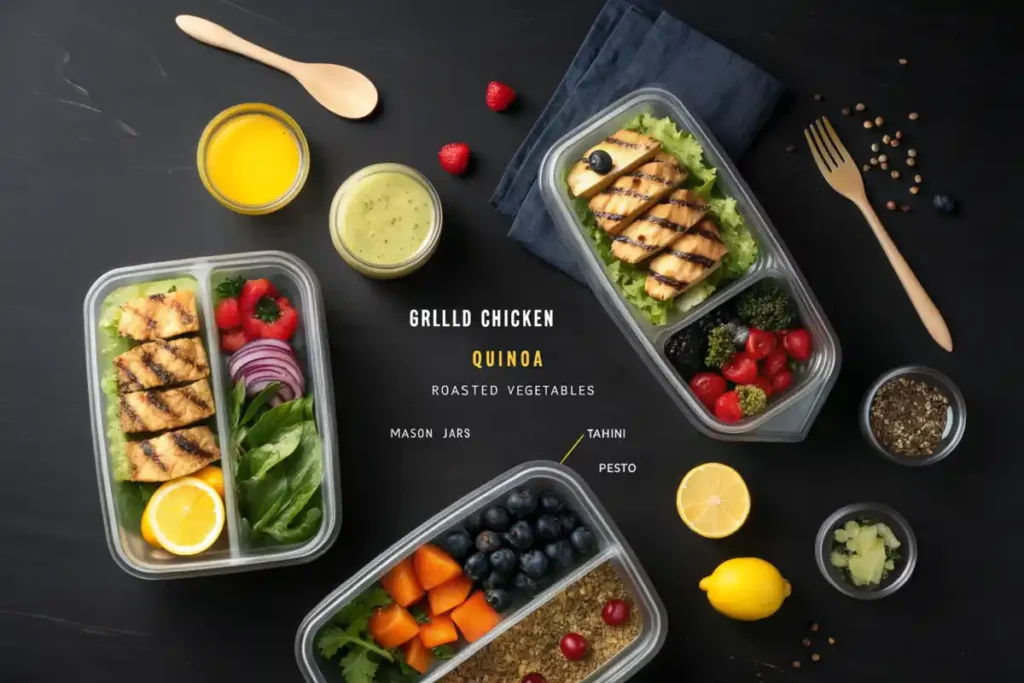
Making Meal Prep Ideas Work for Your Week
Meal prepping makes your life easier by having healthy meals ready when you need them. You can save time and reduce stress by using simple methods like making overnight oats, roasting vegetables, and cooking grains in large amounts. Plus, these meal prep ideas let you change your meals to fit your tastes and dietary needs.
For breakfast inspiration, try creating chia seed pudding or preparing delicious overnight oats for a grab-and-go option. These recipes not only save time but also provide a nutritious start to your day.
Why These Meal Prep Ideas Stand Out
These meal prep techniques offer a balance of efficiency and variety. For instance, starting your day with overnight oats provides a quick and nutritious breakfast option. Additionally, roasting vegetables in advance ensures you always have a versatile side or base for your meals. Cooking grains in bulk is another time saving strategy, giving you a foundation for bowls, salads, or stir fries.
For more savory options, consider trying this easy egg roll in a bowl, a versatile dish that’s perfect for both lunch and dinner. To learn more about the benefits of meal prep and healthy eating
Get Creative with Your Meal Prep
Meal prepping doesn’t have to be repetitive. By experimenting with sauces, spices, and toppings, you can keep every meal exciting. For example, you might pair roasted vegetables with a tahini dressing or toss cooked grains with fresh herbs and lemon juice. Additionally, using divided containers allows you to portion meals perfectly, keeping flavors distinct and fresh.
For dinner, a baked dish like baked ziti is a comforting and filling option that can be prepped in advance.
By combining elements like prepped proteins and vibrant salads, you’ll create balanced meals that you can enjoy throughout the week. With these simple adjustments, meal prep becomes a sustainable and enjoyable habit.
FAQs About Meal Prep Ideas
Meal prep involves planning, preparing, and portioning meals ahead of time. Furthermore, it saves time during busy weekdays, reduces food waste, and helps maintain healthier eating habits. By prepping meals in advance, you can ensure balanced and satisfying options are always available.
To start meal prepping, choose simple recipes and gather your ingredients ahead of time. Additionally, investing in reusable containers and making a meal plan for the week can simplify the process. Creating a shopping list based on your planned meals also ensures you stay organized.
Foods that store well, such as grains, roasted vegetables, grilled proteins, and hearty salads, are ideal for meal prep. Moreover, dishes like soups, stews, and casseroles freeze beautifully and maintain their flavors. Items like overnight oats and smoothie packs are perfect for breakfast prep.
Typically, meal prep dishes last 3-5 days when stored in airtight containers in the refrigerator. However, freezing extends the shelf life of many dishes to up to 3 months. Furthermore, labeling containers with preparation dates helps keep track of freshness.

